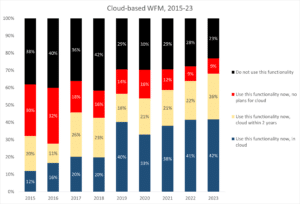Making Workforce Management Work For Agents Too
In older versions of workforce management (WFM), once the forecasts and schedules were set based on historical data and expectation, the opportunity for change was extremely limited and restricted to moving agents between queues and tasks manually: more of an art than a science.
Today, many WFM solutions support rapid changes driven by actual interaction volumes. This is often known as ‘intraday’, a near-real time scheduling system based on actual demand for service and supply of agent availability, and relies upon flexibility from the agent and the enterprise, working together for the benefit of all .
For example:
– the WFM system forecasts the likely volume of interactions through each channel
– resource requirements are forecasted, based on the agent skills required
– agents submit their preferences for working hours (they have contracted to work a certain number of hours each month)
– shift patterns are scheduled and communicated to agents, who have the opportunity to arrange shift swaps with other agents. Businesses may wish agents to be contactable outside of their shift, possibly through SMS or an app, so that any requested schedule alterations or short-notice requests to login can be implemented in a timely fashion
– the WFM system alters schedules accordingly throughout the day, based on real volumes and service levels.
Intraday goes some way to resolving the underlying tension between employee and organisation concerning workforce scheduling, and as such can be seen as part of the broader move towards agent-centric workforce engagement.
It is in the enterprise’s interest to have strictly calculated forecasts and exact allocation of resource, regardless of how this impacts upon the employee. Unsurprisingly, this leads to resentment amongst the workforce, increasing attrition and absence rates. Intraday goes some way to empowering the employee, without putting the enterprise at a disadvantage. WFM solutions that are built with a flexible architecture capable of scheduling in small time-increments (e.g. minutes rather than hours) will support employees’ needs without damaging service levels.
It is important to understand that greater empowerment of agents over their working patterns is greatly beneficial to morale: rather than have to ask a supervisor or manager, they are to a great extent choosing their own hours, with the resulting benefit that they have greater buy-in to the process and are less likely to be absent, as well as reducing the time spent by supervisors in changing schedules manually.
It can be beneficial for everyone to allow agents to change their breaks themselves, bid for shifts and choose their own vacation period through an app without having to run everything through the workforce planning team first. Of course, the service level must be protected and any changes only ratified if this is the case. There’s especially a benefit for remote working agents to have a say in their working patterns, have visibility of their teammates’ shifts, and give options to collaborate with their colleagues. This will promote trust and do away with any issues such as perceived favouritism, as well as protecting the performance of the contact centre.
WFM solutions that are based in the cloud don’t just offer financial benefits: as the time taken to roll out new releases is so much less than the traditional CPE model, vendors can bring out new versions much more frequently, and experiment with offering cutting-edge functionality far sooner than they would in a traditional premise-based deployment environment.
The continued rise in remote working, virtualisation, and mobility in general will be a major driver for the uptake of cloud-based solutions. This model also encourages smaller operations to implement WFM, or experiment with functionality that was previously out of their price range. The chart below shows the significant movement towards cloud-based WFM, with a major jump in 2019 that has been sustained since.

To learn more about workforce management and WFO in general, download “The Inner Circle Guide to Omnichannel Workforce Optimisation”, which draws upon the findings of polling of more than 400 UK and US organisations, free of charge.

